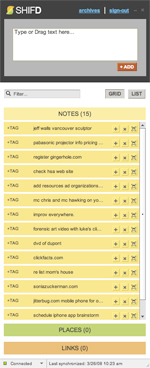ShifD

Simple tools are always the best way to accomplish simple tasks. Such is the case with my new favorite multi-platform app, Shifd. It's basically a really easy way to capture and view notes, places and links from your mobile phone, web browser or computer desktop. I most often use it for mobile notes-to-self; whenever I need to capture a name, place, task or thought I just text it to ShifD. It's added to my list which is accessible from the web page (above) Adobe Air app (below), or iPhone web app.
ShifD was created by Michael Young and Nick Bilton from The New York Times Company's Research and Development Lab. I caught up with them recently to learn about their design process, and to find out why a media company is making tools.
What prompted you to create Shifd?
ShifD came out of us winning Yahoo! Hack Day in London last year. We decided that if we were going to spend 24 hours not sleeping and building something, we should try and build something we could use. We wanted to develop an application that would give us the capability to share content between of all our devices (laptop, mobile, home computer, work computer). We felt that if we can access our email from anywhere, why shouldn't the same thing be possible for our notes, reading lists, and places we want to go.
At Hack Day we built a very 'hacked' version of ShifD by putting RFID into a phone and an RFID reader on a computer so we could detect when the user was at his or her desk by the connection between the RFID embedded phone and RFID reader. If a user was reading something online, when they picked up their phone to walk away, the application knew that connection was broken and would send the rest of the article to their phone to read later. In developing this version of ShifD we eliminated the RFID and made all the content available from any web enabled device.
How did you achieve such simplicity in both features and user experience? Tell us a bit about your design process.
First, thanks for the compliment. As far as the design and user interface process we really wanted to make it as simple as possible,which was achieved by maintaining a consistent look and feel between devices and screen sizes. If you go to ShifD from a mobile device, Web browser or our downloadable Air application, the design and UI are exactly the same and as consistent as we could make them between radically different size screens and devices. We also tried to maintain a good balance between form and function, by not by adding design elements to make things 'look pretty', but by designing to make sense for the user and create a solid, simple user experience.
It seems strange for NYT to be putting out an application. Can you tell us about that relationship?
After we won Hack Day, we presented the concept of ShifD to The Times's executive committee and they were all very excited and supportive of us building on the idea. The concept of ShifD also touches on many of the themes that R&D is working on such as device independent media, creating personal news sources and the convergence of technology around users.
The Times Company is constantly looking for new ways to deliver news and information to consumers in whichever format they choose. ShifD is an experiment in giving users access to news, information and all their content wherever they are and on whichever device they choose.









